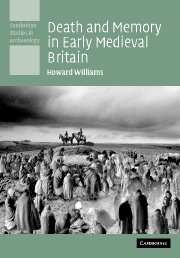3 - Remembering through the body
Published online by Cambridge University Press: 22 September 2009
Summary
Introduction – the early medieval body in death
Hair, skin and flesh are almost never preserved from early medieval graves; in the vast majority of cases, bones are all that survive. Over large areas of the British Isles soil conditions are such that even bone can be in very poor condition or completely obliterated. For example, in the previous chapter we saw that at Harford Farm in Norfolk soil-stains alone indicated the position of the body in the graves dating to the seventh and early eighth centuries AD (see also Bethell & Carver 1987). Excavation methods and techniques are also a factor influencing the degree and quality of the recovered skeletal material (Mays 1998: 13–32). When corporeal remains are identified and recovered, what can they tell us as archaeologists?
When it has been excavated, a great deal can be said about the early medieval body in death: whether it was interred intact, in what position it was placed (extended, flexed or crouched), whether it was supine (facing up), on its left or right side, or prone (facing down). We can discern the body's orientation and whether it was placed alone or together with other bodies. As we saw in the last chapter, regarding Berinsfield, such variations show us differences in the way the deceased was treated and commemorated by those participating in the funeral. Yet the analysis of the bones themselves can tell us a great deal about the life of the dead person.
- Type
- Chapter
- Information
- Death and Memory in Early Medieval Britain , pp. 79 - 116Publisher: Cambridge University PressPrint publication year: 2006

